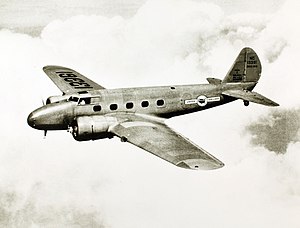Boeing 247
| Boeing 247 | |
|---|---|
 |
|
| United Air Lines Boeing 247D in flight | |
| Role | Passenger airliner |
| Manufacturer | Boeing |
| First flight | February 8, 1933 |
| Introduction | May 22, 1933 |
| Status | Retired |
| Primary user | Boeing Air Transport |
| Number built | 75 |
The Boeing Model 247 was an early United States airliner, considered the first such aircraft to fully incorporate advances such as all-metal (anodized aluminium) semimonocoque construction, a fully cantilevered wing and retractable landing gear. Other advanced features included control surface trim tabs, an autopilot and de-icing boots for the wings and tailplane.
"Ordered off the drawing board", the 247 first flew on February 8, 1933 and entered service later that year. Subsequently, development in airliner design saw engines and airframes becoming larger and four-engined designs emerged, but no significant changes to this basic formula appeared until cabin pressurization and high altitude cruise were introduced in 1940, with the first pressurized airliner, the Boeing 307 Stratoliner.
Boeing had eclipsed other aviation manufacturers by introducing a host of aerodynamic and technical features into a commercial airliner. This advanced design, which was a progression from earlier Monomail (Models 200, 221, 221A) and B-9 bomber designs, combined speed and safety. The Boeing 247 was faster than the U.S. premier fighter aircraft of its day, the Boeing P-12, which was an open-cockpit biplane. Yet its flight envelope included a rather docile 62 mph (100 km/h) landing speed, which precluded the need for flaps, and pilots learned that at speeds as low as 10 mph (15 km/h), the 247 could be taxied "tail high" for ease of ground handling.
The 247 was the first twin-engined passenger transport able to fly on one engine. With controllable pitch propellers (standard equipment on the 247D), the 247 could maintain 11,500 feet (3,500 m) at maximum gross takeoff weight. Its combination of features set the standard for the Douglas DC-1 and other airliners before World War II. Originally planned as a 14-passenger airliner powered by Pratt & Whitney R-1690 Hornet radial engines, the preliminary review of the design concept by United Air Lines' pilots had resulted in a redesign to a smaller, less capable design configuration, powered by R-1340 wasp engines.
...
Wikipedia
